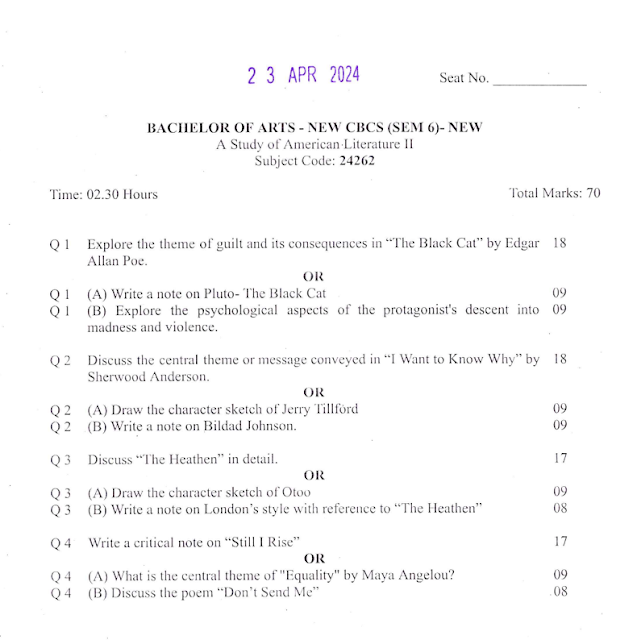Critical analysis of Daniel Defoe’s ‘Robinson Crusoe’ and J. M. Coetzee’s ‘Foe’.
Daniel Defoe's "Robinson Crusoe" and J.M. Coetzee's "Foe" are two novels that engage with similar themes and ideas, yet they do so in markedly different ways. A critical analysis of these two works reveals a complex interplay of colonialism, narrative, and identity.
Colonialism:
"Robinson Crusoe" is often seen as a quintessential colonial novel. It reflects the colonial mindset of the time, where European explorers believed in their divine right to claim and civilize distant lands. Crusoe's attitude towards the indigenous people he encounters, particularly Friday, is paternalistic, reflecting the colonial power dynamics of the era.
In "Foe," Coetzee subverts this colonial narrative. He introduces Susan Barton, a character left out of the original "Robinson Crusoe," who gives voice to the oppressed and subaltern. Coetzee challenges the colonial perspective by highlighting the power imbalances inherent in the colonial project.
World map showing the British Empire in 1902. British possessions colored red.| The Print Collector/Getty Images |
Narrative :
Defoe's novel is framed as Robinson Crusoe's personal journal, emphasizing his role as the sole author of his story. Crusoe's writing is presented as an objective account of his experiences, reinforcing the notion of individualism and the superiority of European culture.
"Foe," on the other hand, explores the act of storytelling itself. Coetzee introduces a character named Foe (representing the author) and problematizes the narrative process. He calls into question the authority of the author and the truth of Crusoe's account. Coetzee's work highlights the ambiguity and subjectivity of storytelling.
Identity and Isolation:
In "Robinson Crusoe," the titular character's journey is one of self-discovery and survival. His isolation on the island forces him to confront his own identity and reevaluate his place in the world.
"Foe" extends this exploration of identity by delving into Susan Barton's quest to tell her story and by introducing the character of Friday. Coetzee raises questions about the construction of identity and the power structures that shape it, particularly in the context of colonialism.
Feminist Perspective:
"Foe" introduces Susan Barton as a strong, independent character who seeks to tell her own story, which was overlooked in "Robinson Crusoe." This novel can be analyzed through a feminist lens as it highlights the role of women in the colonial era, often marginalized and silenced by male-authored accounts.
Metafiction:
"Foe" can be categorized as a work of metafiction, as it self-consciously engages with and revises a classic text. Coetzee's novel prompts readers to reflect on the nature of storytelling, the authority of the author, and the construction of narratives.
Interpretation of Silence:
In "Robinson Crusoe," Friday's silence is interpreted as a sign of his submissiveness to Crusoe. This silence reinforces colonial stereotypes of indigenous people.
"Foe" questions the meaning of silence. It suggests that Friday's silence may be a form of resistance, refusing to speak Crusoe's language and adhere to his worldview.
Postmodern Elements:
"Foe" incorporates postmodern elements such as metafiction, intertextuality, and a self-conscious approach to storytelling. Coetzee's novel invites readers to engage with multiple layers of narrative, challenging traditional storytelling conventions.
Reimagining the Canon:
"Foe" can be seen as an example of postcolonial literature that reimagines and deconstructs a canonical work. It reevaluates the impact and legacy of "Robinson Crusoe" and invites readers to reconsider the narratives that have shaped our understanding of colonialism.
Postcolonial Critique:
"Foe" is often interpreted as a postcolonial critique of "Robinson Crusoe." Coetzee's novel challenges the Eurocentric perspective of the original work, giving voice to marginalized characters and questioning the colonial project.
Summary :
"Robinson Crusoe" represents a colonial-era narrative with a clear Eurocentric perspective, "Foe" by J.M. Coetzee deconstructs and challenges this narrative. Coetzee's novel raises questions about authorship, identity, and power dynamics, offering a postcolonial critique that engages with and reimagines the classic text. When analyzed together, these two works provide a rich opportunity to explore the evolution of literature and colonial discourse.








No comments:
Post a Comment